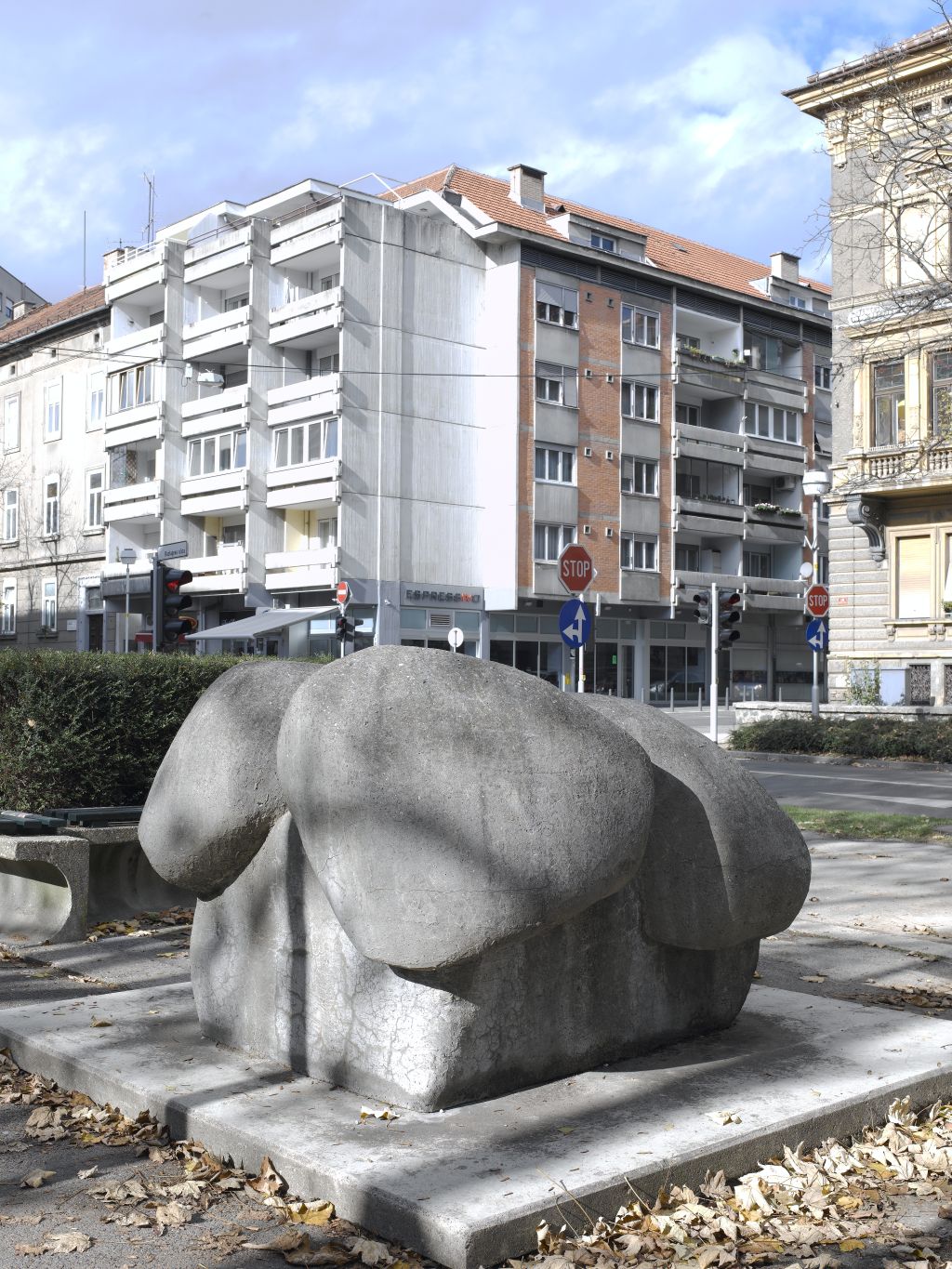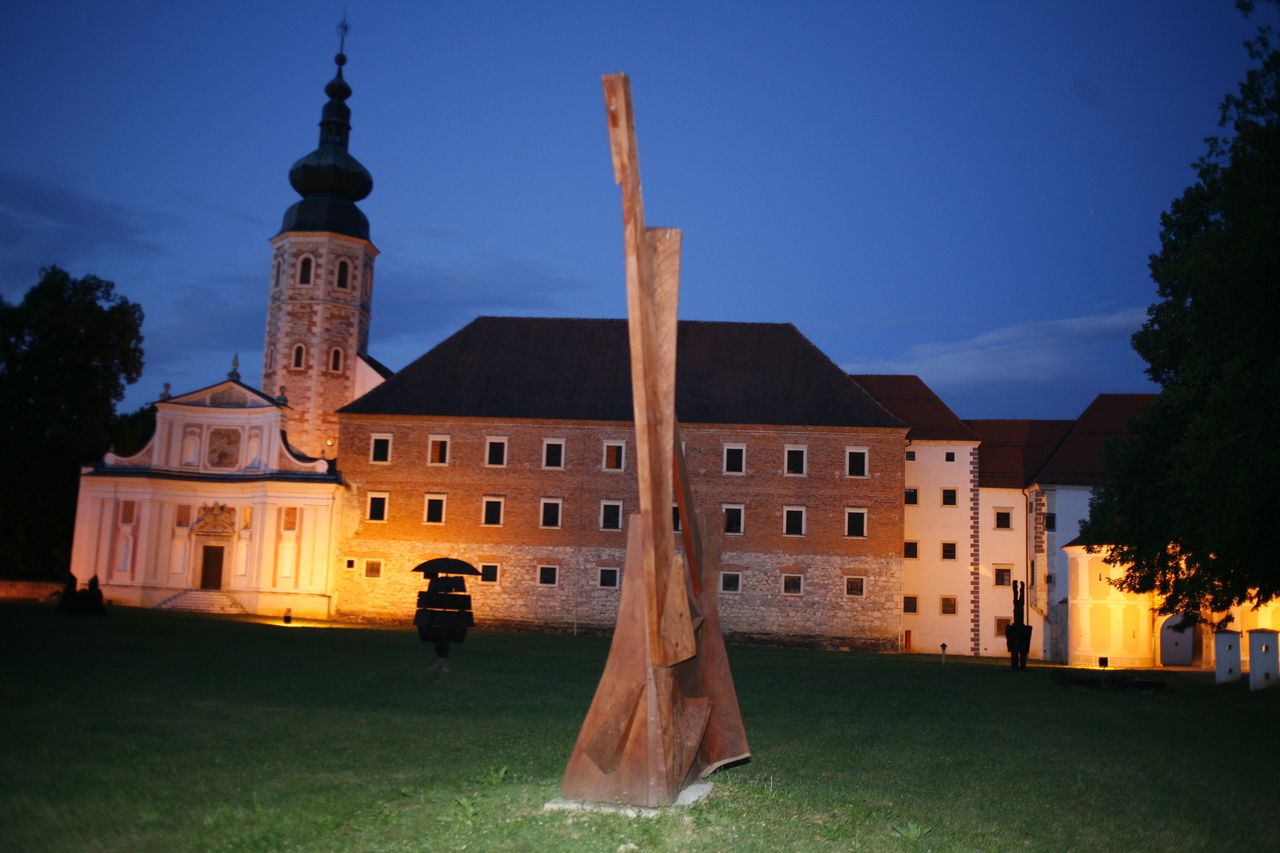Forma Viva Collection
Forma Viva was initially coined as a name for an international sculptors meeting which first took place in 1961 (originally at two different locations) and which has continuously lasted up to this day. Its name, which in Latin stands for living form, soon came to also denote the resultant open-air sculpture collections. They are presented either in specially designated parks or spread across certain urban regions. A rather unique cultural phenomena on a global scale, Forma Viva is supposedly the oldest still active sculptors symposium in the world.
There are four Forma Viva collections, located at roughly the four corners of Slovenia &Ndash; in Maribor (the main city of the Eastern regions), in Seča (near the coastal town of Portorož), in Kostanjevica na Krki (a small island town located on the river Krka) and in Ravne na Koroškem, the central town of the Koroška region. While the ones in Seča and Kostanjevica are more or less limited to their respective parks, the Maribor collection is spaced across the whole of the city. The Ravne na Koroškem collection is even more dispersed and the works grace a number of towns across the wider region.
 Flower (125 x 175 x 175 cm), reinforced concrete by Mojca Smerdu from 1983, located in front of the Faculty of Economics and Business, part of the Forma Viva Open Air Sculpture Collection, Maribor
Flower (125 x 175 x 175 cm), reinforced concrete by Mojca Smerdu from 1983, located in front of the Faculty of Economics and Business, part of the Forma Viva Open Air Sculpture Collection, Maribor
Background
Forma Viva was modelled after a Bildhauersymposion St. Margarethen, first held in the quarry at Sankt Margarethen in 1959 and organised by Karl Prantl. This event greatly inspired a pair of Slovene sculptors, Janez Lenassi and Jakob Savinšek, who visited the meeting in 1959 and in 1960. They formulated an idea of an annual international open air workshop and coined the name that alluded to the meeting as a means of exploring living sculpture in ever new directions.
They've built the project on the basis of pre-existing cultural activities in their respective home towns, with Lenassi starting to prepare the project already in 1959. The basic premise of the project was monumental and essentially public sculpture, which almost by default demanded to be created in situ and which was also hard to realise for gallery usage. The organiser took care of the material, tools and provided for the artists while they've donated their works to the collections. The symposium was an international meeting, and though there were two sites, in the first year the invited artists were meant to meet each other and watch each other working.
A very distinctive specific of Forma Viva since its inception is its focus on the specific materials used at any particular site, bound to have have some sort of a connection to the region.
A brief history
The first two symposia started in 1961, the first one in Seča near Portorož (working exclusivekly with stone) and the other in Kostanjevica na Krki (here wood has been used ever since). Later, two other venues were included: Ravne na Koroškem (1964, steel) and Maribor (1967, reinforced concrete). Other locations proposed during that time were Jesenice (iron), Ptuj (aluminium or umetne mase) and Radenci (clay).
At first, the founders held annual symposia in both Portoroz and Kostanjevica but, for economic reasons, this had to be curtailed after a few years. Portorož and Kostanjevica started to hold the symposia alternately, each every two years. The Maribor symposium happened a bit more sporadically until 1986 (when it stopped and hasn't been revived as of yet), while the Ravne one lasted till 1989 and got resurrected in 2008. Between 1988 and 1998 there was no co-ordination between the symposia in Seca and those in Kostanjevica. The year 1991 marked an end of an era as Seča remained the only one of the four that maintained continuity, though on a biennial nature. Recent years have seen a resurgence of Forma Viva activities, though they still haven't retained its former ambitiousness.
In the past decades a few other Forma Viva's has risen, most notably in zrece and Makole. They were done independently as compared to the initial four, which share a overarching organisational entity. The Zrece Forma Viva began to take shape in mid-1970s and and the collection was growing until 1989. It is a result of cooperation between the artist Vasilij Cetkovic and Marjan Osole, who was the managing director of the tools company Unior at that time. Built on the the blacksmith tradition of the area, they created eight pieces made from iron, steel and artificial grindstones. The sculptures were all made from materials available locally.
The works
Each of these collections is based on a particular material, distinctive for the area. In accordance with the natural resources of individual sites, the symposium in Kostanjevica na Krki focuses on sculpting oak wood (there is only one piece made of some other material, yet set in a living tree), Seca near Portorož on the hard and resistant bright Istrian limestone (among other things it is used for the fountains in Venice), Ravne na Koroškem on metal (where the steel making plant intiated and finaced the project), and Maribor on reinforced concrete (which corresponded with the burgeoning building of concrete neighbourhoods, with the concrete also provded by one of the local companies, called Stavbar).
The materials also correspond to the spatial logics, with the stone and wooden collections comprising a more traditional exhibitions and the concrete and steel ones being integrated into the urban fabric. More then 100 sculptures are on display in natural environment nearby art museum/former cistercian monastery in Kostanjevica na Krki (with some pieces, like the constructivist sculpture by Vjenceslav Richter (HR), also set at various rad junctures in the area). From their symposia, the curators of the Coastal Galleries at Piran, who are in charge of the park, collected over 300 pieces of sculpture for the park at Portorož alone. These are now distributed around the several parks on the Slovenian coast, as originally planned over fifty years ago. Also,
As the collections are now quite old and mostly rather monumental, they demanded extensive renovating tecniques to be developed. In 2005, the Koroška Regional Museum started to gradually renovate all of the pieces.
 Exterior of Božidar Jakac Art Museum in the former Kostanjevica Monastery, Kostanjevica na Krki. In front: a sculpture from the Forma Viva Open Air Wood Sculpture Collection
Exterior of Božidar Jakac Art Museum in the former Kostanjevica Monastery, Kostanjevica na Krki. In front: a sculpture from the Forma Viva Open Air Wood Sculpture Collection
Impact
Besides serving as notable landmarks, Forma Viva has also been an important way of penetration of contemporary art into the wider community. Works were done with the cooperation of local craftsman and – in the case of Ravne – the workers in the local iron factory. The working sites were also freely accessible and often, especially in the early decades, they were the only time when local people met foreigners, especially the ones coming from such faraway countries as Japan (worth mentioning is that Japanese artists represented the biggest part of the artists invited).
At the same time this international symposium was very important for the development of sculptor-ship in Slovenia, bringing contemporary modelling principles amongst the artistic communities. Besides the Biennial of Graphic Arts and Biennial of Design (BIO) this has been among the most important institutions of Slovene visual arts.
External links
- Forma Viva Open Air Wood Sculpture Collection in Kostanjevica na Krki website (in Slovenian)
- Forma Viva, Ravne na Koroškem website (in Slovenian)
- Forma Viva Open Air Stone Sculpture Collection, Seca website (in Slovenian)
- Forma Viva Maribor on the Maribor Art Gallery website (in Slovenian)
- A webpage on the Zreče Forma Viva
- A map of the Maribor Forma Viva pieces (in Slovenian)
- An archival TV news piece about Forma Viva from 1974 (in Slovenian)
- An extensive history of Forma Viva (in Slovenian)
- [1] (in Slovenian)
- A graduation thesis about the history of Forma Viva (in Slovenian)
Articles in category "Forma Viva Collection"
The following 9 pages are in this category, out of 9 total.
F
Media in category "Forma Viva Collection"
The following 38 files are in this category, out of 38 total.
- Bozidar Jakac Art Museum 2007 exterior sculpture Photo Borut Peterlin.jpg 2,400 × 1,600; 2.57 MB
- Bozidar Jakac Art Museum 2011 Karen Macher Nesta Natural Seesaw.JPG 2,560 × 1,920; 1.55 MB
- Bozidar Jakac Art Museum 2014 Agnessa Ivanova Petrova Streams.jpg 5,760 × 3,840; 11.85 MB
- Bozidar Jakac Art Museum 2014 Donald Buglass Vessel Photo Tomaz Grdin.jpg 5,538 × 3,692; 9.31 MB
- Bozidar Jakac Art Museum 2014 Mitja Stanek QR Code Photo Tomaz Grdin.jpg 5,641 × 3,761; 9.14 MB
- Dragica Cadez Lapajne 1973 Photo Damjan Svarc.jpg 1,024 × 768; 205 KB
- Forma Viva Open Air Sculpture Collection Maribor 2008 Banzo Matsura.jpg 4,008 × 5,344; 13.95 MB
- Forma Viva Open Air Sculpture Collection Maribor 2008 Dragica Cadez Lapajne.jpg 1,417 × 945; 1.9 MB
- Forma Viva Open Air Sculpture Collection Maribor 2008 Maciej Szankowski.jpg 5,344 × 4,008; 23.05 MB
- Forma Viva Open Air Stone Sculpture Collection Portoroz 2020 Photo Kaja Brezocnik (1).jpg 2,048 × 1,365; 1.53 MB
- Forma Viva Open Air Stone Sculpture Collection Portoroz 2020 Photo Kaja Brezocnik (2).jpg 2,048 × 1,368; 1.15 MB








































